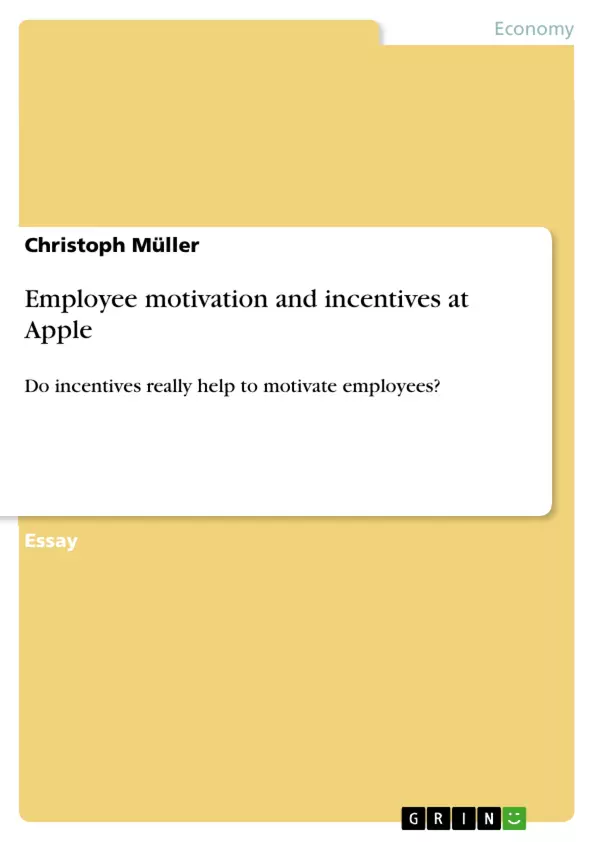This paper critically evaluates whether incentives really help to motivate employees. For this purpose it provides a clear definition of motivation, points out why existing theories are partly outmoded and introduces a new model in order to gain a holistic view of the motivation concept. As the paper progresses it will be dealt with appropriate theories and practical examples of Apple in order to promote understanding of the key aspects of incentives.
Table of Contents
- Motivation Factors Model
- Incentives and Threats
- What is Motivation?
- What Makes a Good Incentive?
- The Impact of Incentives on Motivation
- The Importance of Recognition
- Total Reward Systems
- The Role of Leadership
- Conclusion
Objectives and Key Themes
This paper aims to critically evaluate the effectiveness of incentives in motivating employees. It provides a comprehensive understanding of motivation by examining existing theories, their limitations, and proposing a new model that integrates various influencing factors. The paper explores the role of both intrinsic and extrinsic motivation, emphasizing the importance of a holistic approach to employee motivation.
- The concept of employee motivation and its multifaceted nature
- The impact of incentives and threats on employee motivation
- The role of organizational culture, leadership, and benefits in fostering motivation
- The effectiveness of different types of incentives, both financial and non-financial
- The importance of recognition and its potential to enhance employee motivation
Chapter Summaries
- Motivation Factors Model: This chapter introduces a comprehensive model that encompasses external, organizational, and individual factors influencing employee motivation. It highlights the interconnectedness of these elements and emphasizes that incentives and threats are only part of the overall motivation process.
- Incentives and Threats: This chapter delves into the concept of incentives and threats as key bases of power. It explores the theory that motivation arises from both intrinsic and extrinsic factors, emphasizing the need for a balance between the two.
- What is Motivation?: This chapter provides a definition of motivation and examines existing theories, including Maslow's hierarchy of needs, McGregor's XY theory, and Herzberg's two-factor theory. It highlights the limitations of these theories and underscores the need for a more comprehensive approach.
- What Makes a Good Incentive?: This chapter explores the debate surrounding the effectiveness of different types of incentives. It examines various perspectives on the role of money, recognition, and other non-financial rewards in motivating employees.
- The Impact of Incentives on Motivation: This chapter examines the potential drawbacks of performance-related rewards and explores the idea that incentives can sometimes have a negative impact on intrinsic motivation. It discusses the importance of considering individual needs and aspirations when implementing incentive programs.
- The Importance of Recognition: This chapter emphasizes the role of recognition as a powerful motivator. It suggests that organizations should focus on recognizing employee contributions and achievements through various means, including verbal praise, gifts, and symbolic gestures.
- Total Reward Systems: This chapter advocates for the adoption of total reward systems that incorporate both financial and non-financial incentives. It highlights the success of companies like Apple, which have implemented such systems to foster employee motivation.
- The Role of Leadership: This chapter discusses the influence of leadership on employee motivation. It argues that effective leaders can create a positive work environment that encourages commitment and fosters intrinsic motivation. It also explores the potential impact of different leadership styles on employee motivation.
Keywords
The main keywords and focus topics of the text include employee motivation, incentives, threats, intrinsic motivation, extrinsic motivation, organizational culture, leadership, benefits, recognition, total reward systems, and the impact of external factors on motivation. The paper delves into the complexities of motivating employees and explores various theories and perspectives on the subject.
- Quote paper
- Christoph Müller (Author), 2010, Employee motivation and incentives at Apple, Munich, GRIN Verlag, https://www.grin.com/document/167839



